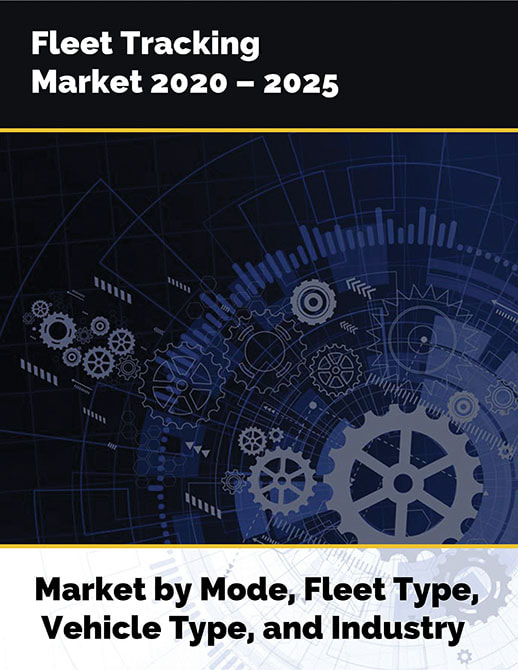- IoT & M2M
- >
- Fleet Tracking Market by Mode Fleet Type , Vehicle Type, Industry Verticals and Regions 2020 – 2025
Fleet Tracking Market by Mode Fleet Type , Vehicle Type, Industry Verticals and Regions 2020 – 2025
This fleet tracking market report evaluates fleet tracking technologies, solutions, and ecosystem including major players. The report assesses the impacts of various use cases and specific considerations in terms of asset technology and solution selection. The report also analyzes the outlook for fleet tracking market globally and regionally. Quantitative data and forecasts include market segmentation by Mode (Air, Roadway, Railway, and Water) Fleet Type (Services, Transport, Taxi, Special Purpose), Vehicle Type (Car, Container, Rail, Plane, Ship, Truck, Van), Industry Verticals and Region from 2020 to 2025.
A sub-set of the overall asset tracking market, the fleet tracking market represents those solutions that leverage various technologies (GPS, M2M/IoT, embedded and adjunct devices, on-board and remote computing, etc.) to provide solutions for tracking land-based commercial wheeled or tracked motor vehicles including trucks, trailers, vans, cars, special-purpose vehicles, and other fleet assets. Land-based fleet tracking also includes private cars, trucks, and vans used for business purposes. The fleet tracking market also includes air-based (drones, fixed-wing aircraft, and helicopters) and water-based craft (tankers, container vessels, ferries, etc.)
Select Research Findings:
· Fleet is rapidly moving to a cloud-based support approach, especially with edge computing
· Fleets are largely not connected today, representing huge upside for the fleet management market
· Largely untapped SMB market that segment represents 68% of the market, but 70% have no telematics
· Leading fleet management companies are moving clients towards a transaction-based self-service model
· Integrating artificial intelligence algorithms provides opportunities for value-added fleet management services
Published: February 2020
Pages: 191
Global Enterprise License: $ 4,000 USD
Overview:
This fleet tracking market report evaluates fleet tracking technologies, solutions, and ecosystem including major players. The report assesses the impacts of various use cases and specific considerations in terms of asset technology and solution selection. The report also analyzes the outlook for fleet tracking market globally and regionally. Quantitative data and forecasts include market segmentation by Mode (Air, Roadway, Railway, and Water) Fleet Type (Services, Transport, Taxi, Special Purpose), Vehicle Type (Car, Container, Rail, Plane, Ship, Truck, Van), Industry Verticals and Region from 2020 to 2025.
A sub-set of the overall asset tracking market, the fleet tracking market represents those solutions that leverage various technologies (GPS, M2M/IoT, embedded and adjunct devices, on-board and remote computing, etc.) to provide solutions for tracking land-based commercial wheeled or tracked motor vehicles including trucks, trailers, vans, cars, special-purpose vehicles, and other fleet assets. Land-based fleet tracking also includes private cars, trucks, and vans used for business purposes. The fleet tracking market also includes air-based (drones, fixed-wing aircraft, and helicopters) and water-based craft (tankers, container vessels, ferries, etc.)
Historically speaking, the fleet tracking market has largely served two primary purposes: (1) improving operational efficiency and (2) supporting regulatory compliance. Regarding the latter, important metrics include location, average speed, acceleration/deceleration, incident reporting (such as when brakes are applied and duration), engine malfunctions, drive time, and other data useful for fulfilling both regulations as well as legal and business requirements in the event of a claim against services, condition of goods, damages or injury.
Target Audience:
- AI companies
- M2M and IoT companies
- Logistics services companies
- Systems integration companies
- Fleet management service providers
- Asset tracking software and services companies
- Fleet is rapidly moving to a cloud-based support approach, especially with edge computing
- Fleets are largely not connected today, representing huge upside for the fleet management market
- Largely untapped SMB market that segment represents 68% of the market, but 70% have no telematics
- Leading fleet management companies are moving clients towards a transaction-based self-service model
- Integrating artificial intelligence algorithms provides opportunities for value-added fleet management services
- Advantrack
- Alphabet
- ARI Fleet
- Arvento
- AT&T (Fleet Complete)
- Azuga Fleet
- Blackberry (Radar, QNX)
- Carmalink
- ClearPath GPS
- DriveFactor
- Estrack
- Fleet Complete
- Fleet Safety Institute
- Fleetilla
- Fleetistics
- FleetManager
- FleetMind
- Fleetup
- Geotab
- Globalstar
- Go Fleet
- GPS Insight
- GPS Trackit
- Gsattrack
- Gurtam
- Inseego
- IntouchGPS
- Lojack
- Lytx
- M2M in Motion
- Mix Telematics
- Momentum IoT
- NexTraq
- Omnitracs
- Passtime
- Pedigree Technologies
- Raven Connected
- Rhino Fleet
- Roambee
- SafeFleet
- Samsara
- Skybitz
- Smart Path GPS
- Spireon (FleetLocate)
- Sprint
- T-Mobile Partnering
- Telefonica
- Teletrac Navman
- Tenna
- TomTom
- Trimble
- Verizon Connect
- Vodafone
- Zonar Systems
- Zubie
1.0 Executive Summary
2.0 Introduction
2.1 Fleet Tracking Overview
2.1.1 Fleet Tracking Functions
2.1.2 Fleet Tracking Systems
2.2 Fleet Tracking Business Drivers
2.2.1 Connected Devices, Equipment, and Vehicles
2.2.1.1 Connected Consumer Devices: Homes, Automobiles, and More
2.2.1.2 Connected Enterprise Assets: Beyond Commercial Fleets
2.2.1.3 Connected Industrial Assets: Special Purpose Vehicles and Equipment
2.3 Fleet Tracking Technologies and Integration
2.3.1 Onboard Vehicle Telematics
2.3.1.1 Presence and Location Determination
2.3.1.2 Machine to Machine (M2M) and Internet of Things (IoT)
2.3.1.3 Command and Control of Enterprise Assets
2.3.2 Fleet Tracking Computing
2.3.2.1 Embedded and On-board Computing
2.3.2.2 Remote Servers and Computing
2.3.2.3 Cloud and Edge Computing
2.3.3 Fleet Tracking Devices
2.3.3.1 Embedded Devices
2.3.3.1.1 Automatic Onboard Recording Devices (AOBRD)
2.3.3.1.2 Electronic Logging Devices (ELD)
2.3.3.2 Plug and Play OEM Devices
2.3.3.2.1 On-board Diagnostic (OBD) Port Enabled
2.3.3.2.2 Other OEM Devices
2.3.4 Command and Control
2.3.4.1 Fleet Management Systems and Solutions
2.3.4.1.1 Asset Management Data
2.3.4.1.2 Personnel Management Data
2.3.4.2 Integrating Big Data Analytics with Tracking
2.3.5 Other Technology Considerations
2.3.5.1 Mobility Management and Connectivity Technology
2.3.5.2 5G and Multi-access Edge Computing
2.3.5.3 Artificial Intelligence in Fleet Tracking
2.3.5.4 Advanced Data Analytics Support of Fleet Tracking
2.3.5.5 Blockchain Technology and Fleet Tracking
2.3.5.6 Autonomous Vehicles
3.0 Fleet Tracking Solution Considerations
3.1 Tracking Vehicle Utilization
3.1.1 Hours of Service
3.1.2 Idle Time vs. Usage
3.1.3 Vehicle Lifecycle Management
3.2 Vehicle Monitoring
3.2.1 Tracking Location and Boundaries
3.2.2 Speed, Acceleration, and Proximity
3.3 Fleet Tracking Data Analysis and Analytics
3.3.1 Monitoring Location and Boundaries (Geo-fencing)
3.3.2 Maintenance and Services Notification
3.3.3 Cargo Safety: Food and Perishables
3.3.4 Logistics and Resource Utilization Optimizing Programs
3.3.5 Real-time and Predictive Business Decision Making
3.3.6 Vehicle and Support Systems Re-engineering
4.0 Fleet Tracking Solutions
4.1 Vehicle Tracking
4.2 Commercial Fleet Tracking
4.3 Autonomous Vehicle Fleets and Tracking
4.3.1 Navigation and Mapping
4.3.2 Machine Vision and Motion Planning
4.3.3 Trajectory Control
4.3.4 Video Camera and GPS System
4.3.5 Traffic Detection and Assistance
4.3.6 Sensing Systems: Ultrasonic, LIDAR, and Others
5.0 Fleet Tracking in Industry Verticals
5.1 Aviation and Aerospace
5.2 Automotive and Transportation Systems
5.3 Government (State and Local)
5.4 Robotics and Drones
6.0 Vendor Ecosystem and Company Analysis
6.1 Vendor Ecosystem
6.1.1 Original Equipment vs. OEM Vendors
6.1.2 Asset Leasing and Lending Companies
6.1.3 Vehicle Manufacturers
6.1.4 Hardware Providers (GPS, Devices, others)
6.1.5 Software and Application Developers
6.1.6 Service Providers including Fleet Management as a Service
6.2 Select Company Analysis
6.2.1 Azuga Fleet
6.2.2 Blackberry (Radar, QNX)
6.2.3 Carmalink
6.2.4 ClearPath GPS
6.2.5 DriveFactor (or CCC Drive)
6.2.6 Estrack
6.2.7 Fleet Safety Institute
6.2.8 Fleetilla
6.2.9 Fleetistics
6.2.10 FleetManager
6.2.11 FleetMind (Safe Fleet Holdings)
6.2.12 Fleetup
6.2.13 Geotab
6.2.14 Globalstar
6.2.15 Go Fleet
6.2.16 GPS Insight
6.2.17 GPS Trackit
6.2.18 GSAttrack (Global Satellite Engineering)
6.2.19 Gurtam
6.2.20 Inseego
6.2.21 IntouchGPS (GPSTrackit)
6.2.22 Lojack
6.2.23 Lytx
6.2.24 M2M in Motion
6.2.25 Mix Telematics
6.2.26 Momentum IoT
6.2.27 NexTraq (Michelin)
6.2.28 Omnitracs
6.2.29 Passtime
6.2.30 Pedigree Technologies
6.2.31 Raven Connected (KlashWerks Inc.)
6.2.32 Rhino Fleet
6.2.33 Roambee
6.2.34 SafeFleet
6.2.35 Samsara
6.2.36 Skybitz
6.2.37 Smart Path GPS
6.2.38 Spireon Inc.
6.2.39 Sprint Corporation
6.2.40 Teltrac Navman
6.2.41 Tenna
6.2.42 T-Mobile
6.2.43 TomTom International BV
6.2.44 Verizon Wireless
6.2.45 Vodafone Limited
6.2.46 Zonar Systems (Continental AG)
6.2.47 Zubie
7.0 Fleet Tracking Market Analysis and Forecasts 2020 – 2025
7.1 Global Asset Tracking Market
7.2 Fleet Tracking Market
7.2.1 Fleet Tracking Market Drivers
7.2.1.1 Improving Efficiency and Productivity
7.2.1.2 Reducing Vehicle Investment Risks
7.2.1.3 Government Regulations and Compliance
7.2.1.3.1 Federal Motor Carrier Safety Administration
7.2.1.3.2 Other Regulations
7.2.1.4 Safety and Sustainability
7.2.1.4.1 Location Traceability
7.2.1.4.2 Usage and Maintenance
7.2.1.5 Logistics Optimization
7.2.1.5.1 Tracking and Tracing
7.2.1.5.2 Route Planning and Navigation
7.2.1.6 Additional Connected Vehicle Related Market Needs
7.2.1.6.1 V2X and Collision Prevention
7.2.1.6.2 Other IoT Integration Market Drivers
7.2.2 Fleet Tracking Industry Verticals and Business Types
7.2.2.1 Enterprise
7.2.2.1.1 Commercial Fleets
7.2.2.1.2 Short and Long-haul Trucking
7.2.2.2 Industrial
7.2.2.2.1 Material Handling Vehicles
7.2.2.2.2 Special Purpose Vehicles
7.2.2.3 Government
7.2.2.3.1 Public Safety Vehicles
7.2.2.3.2 Special Use Vehicles
7.2.3 Fleet Tracking Market Forecasts
7.2.3.1 Fleet Tracking Market by Land and Non-Land Based Vehicles
7.2.3.2 Fleet Tracking Market by Fleet Land Based Vehicle Type
7.2.3.3 Fleet Tracking Market by Commercial/Industrial Fleet Type
7.2.3.4 Fleet Tracking Market in Fleets by Truck and Van Type
7.2.3.5 Fleet Tracking Market in Fleets by Long Haul Tracking Type
7.2.3.6 Fleet Tracking Market in Fleets by Truck Wheel Size
7.2.3.7 Fleet Tracking Market in Fleets by Truck Length
7.2.3.8 Fleet Tracking Market by Fleet Service Vehicle Type
7.2.3.9 Fleet Tracking Market by Fleet Trailer Type
7.2.3.10 Fleet Tracking Market in Fleets by Bus Type
7.2.3.11 Fleet Tracking Market in Fleets by Service Bus Type
7.2.3.12 Fleet Tracking Market by Consumer/Personal Fleet
7.2.3.13 Fleet Tracking Market by Special Purpose Fleet
7.2.4 Fleet Tracking Market by Non-Roadway Based Vehicle Type
7.2.4.1 Fleet Tracking Market by Aviation Vehicle and Support Equipment
7.2.4.2 Fleet Tracking Market by Railway Vehicle and Equipment
7.2.4.3 Fleet Tracking Market by Water Based Vehicle Type
7.3 Fleet Tracking Market by Unit Deployment
7.3.1 Fleet Tracking Unit Deployment by Fleet Management
7.3.1.1 Fleet Tracking Unit Deployment by Land and Non-Land Vehicle
7.3.1.1.1 Fleet Tracking Unit Deployment by Land Based Vehicle Type
7.3.1.1.2 Fleet Tracking Unit Deployment by Commercial Fleet Type
7.3.1.1.3 Fleet Tracking Unit Deployment by Truck and Van Type
7.3.1.1.4 Fleet Tracking Unit Deployment by Long Haul Tracking Type
7.3.1.1.5 Fleet Tracking Unit Deployment by Truck Number of Wheels
7.3.1.1.6 Fleet Tracking Unit Deployment by Truck Length
7.3.1.1.7 Fleet Tracking Unit Deployment by Service Vehicle Type
7.3.1.1.8 Fleet Tracking Unit Deployment by Trailer Type
7.3.1.1.9 Fleet Tracking Unit Deployment by Bus Type
7.3.1.1.10 Fleet Tracking Unit Deployment by Service Bus Type
7.3.1.1.11 Fleet Tracking Unit Deployment by Consumer/Personal Fleet Type
7.3.1.1.12 Fleet Tracking Unit Deployment by Special Purpose Fleet Type
7.3.1.1.13 Fleet Tracking Unit Deployment by Roadway Based Vehicle Type
7.3.1.1.14 Fleet Tracking Unit Deployment by Aviation Vehicle and Machinery Type
7.3.1.1.15 Fleet Tracking Unit Deployment by Railway Vehicle and Equipment Type
7.3.1.1.16 Fleet Tracking Unit Deployment by Water Based Vehicle Type
8.0 Conclusions and Recommendations
Figures
Figure 1: 3D Simulation Platform
Figure 2: Autonomous Vehicle Technology
Figure 3: Real Time GPS Satellite based Vehicle Tracking
Figure 4: GPS based Industrial Fleet Tracking
Figure 5: Machine Vision Specimen
Figure 6: Automotive Camera
Figure 7: Artificial Perception System
Figure 8: Radar Technology
Figure 9: Solid State Lidar Unit
Figure 10: In-Flight Asset Management
Figure 11: Public Infrastructure Tracking
Figure 12: Satellite based Disaster Tracking Management
Figure 13: Global Consolidated Asset Tracking Market 2020 – 2025
Figure 14: Global Fleet Tracking Unit Deployment 2020 – 2025
Tables
Table 1: Global Asset Tracking Market by Asset Category 2020 – 2025
Table 2: Global Fleet Tracking Market by Fleet Management Category 2020 – 2025
Table 3: Global Fleet Tracking Market by Land Based Vehicle Type 2020 – 2025
Table 4: Global Fleet Tracking Market by Commercial/Industrial Fleet Type 2020 – 2025
Table 5: Global Fleet Tracking Market by Trucks and Van Type 2020 – 2025
Table 6: Global Fleet Tracking Market by Long Haul Tracking (LHT) Type 2020 – 2025
Table 7: Global Fleet Tracking Market by LHT Wheeler Type 2020 – 2025

